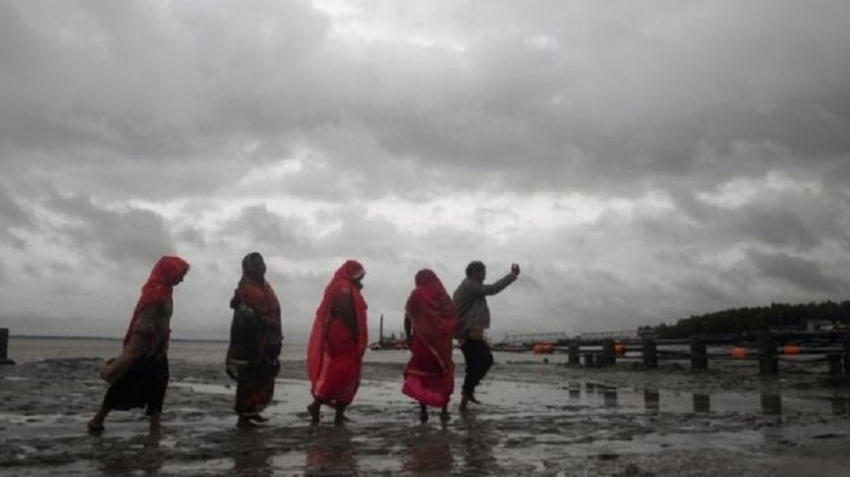Cyclone Bulbul has ripped through coastal areas of Bangladesh and India, killing at least 13 people while more than two million others were forced to spend a night in storm shelters.The storm packed winds of up to 120km/h (75 mph), injuring dozens and destroying thousands of homes.Five of the six who lost their lives in Bangladesh were hit by falling trees.Officials say that further casualties were avoided because people were evacuated in time.Authorities say the storm is now weakening.What damage did Cyclone Bulbul cause?Seven people were killed in the Indian state of West Bengal, the state's minister for disaster management told reporters.
West Bengal is one of the worst hit areas in IndiaThe five victims hit by trees in Bangladesh included a 52-year old woman who died when a tree dropped onto her house.A 60-year-old fisherman also lost his life after ignoring evacuation warnings.There are increasing concerns after two fishing boats carrying more than 30 men failed to return, an official in Bangladesh's Bhola district said.Around 1,200 tourists, most of them Bangladeshi, were stuck on St Martin's Island, part of Cox's Bazar district, an official told the Reuters news agency."All of them will be rescued," he said.Services at many sea ports and airports in the region were also suspended - including the busy Kolkata airport.Bangladesh's two biggest ports, Mongla and Chittagong, were closed and flights into Chittagong airport were stopped.Storms have battered areas of Bangladesh Bangladesh's low-lying coast is often hit by deadly cyclones, but the country has successfully reduced the number of casualties in recent years.
Cyclone Fani: More than 1,000 Bangladesh homes destroyed
A marooned couple sit on a log close to their home, surrounded by flood water
Cyclone Fani has caused extensive damage in Bangladesh, despite weakening as it blew north from India.
More than 1,000 homes have been destroyed and entire villages submerged in the South Asian country.
At least five people died and 63 were injured.
With more than a million people evacuated to safety, the director of the Bangladesh Meteorological Department said "fear of a major disaster is mostly over".
People try to fix their damaged homes in Khulna, Bangladesh
The cyclone was downgraded to a depression as it swept north-eastwards from India into Bangladesh on Saturday, but was still powerful enough to submerge dozens of villages on the low lying coast.
Gusts of up to 70km/h (43mph) were registered.
Houses were also destroyed in the Noakhali district, where 30 people were injured and two children killed, one aged 12 and another two years old.
India also moved more than a million people to safety to avoid Cyclone Fani.
A least 16 people were killed by the storm when it hit India on Friday, but officials said the loss of life could have been far worse.
In 1999, a super-cyclone in the Bay of Bengal ravaged the coast of Orissa for 30 hours and killed 10,000 people.
Early cyclone warning systems have since improved, giving authorities more time to evacuate people. The chief minister of Orissa said this was one of the largest evacuations in human history.
Cyclone Fani evacuation efforts hailed a success
4 May 2019
Share this with Facebook Share this with Messenger Share this with Twitter Share this with Email Share
Related TopicsCyclone Fani
Image copyrightEPA
Image caption
Efforts to reduce loss of human life have been called a success
India has hailed as a success its evacuation of more than a million people to safety to avoid Cyclone Fani.
Sixteen people were killed in the north-eastern Indian state of Orissa, or Odisha, by the storm which hit there on Friday.
Officials said the loss of life could have been far worse.
Yet storm surges and powerful winds have still ravaged the state, flooding at least 36 villages and destroying 2,000 homes.
Puri, the seaside temple town where Fani made landfall, suffered colossal damage, as winds reaching 200km/h (125mph) blew off roofs, damaged power lines and uprooted trees.
Arun Bothra, inspector-general of Orissa police, praised efforts to keep people safe.
"There has been massive, massive damage here…but fortunately, thanks to the people who forecasted this and told us the minute-to-minute movement of the cyclone, the government has been able to evacuate 1.2 million people," Mr Bothra told the BBC.
"The evacuation part was very successful and the casualties are very, very low," he said.
Media captionCyclone Fani damage
The next phase of returning people to their homes had already started and would continue for the next four to five days, before the huge task of restoring damaged buildings starts, Mr Bothra added.
Orissa-based relief official Bishnupada Sethi told Reuters that the "destruction is unimaginable" in Puri, which lay directly in the path of Fani.
Aerial pictures showed extensive flooding in the area, home to the 858-year-old Jagannath temple.
Image copyrightAFP
Image caption
Storm damage in a residential area of Puri
Image copyrightGETTY IMAGES
Image caption
Damaged auto rickshaws in Puri
Fani struck Orissa in the early hours of Friday before moving north-east towards Bangladesh, where it weakened on Saturday.
Gusts up to 70km/h (43mph) were registered in Bangladesh. It was categorised as a deep depression.
Dozens of villages on the Bangladesh coast have been submerged, officials say, and more than a million people have been moved to safety.
At least four people have been killed and 63 injured, Bangladesh's junior disaster minister Enamur Rahman told reporters.
The storm destroyed several houses in the Noakhali district, where a two-year-old child was killed and about 30 people were injured, a local official told Reuters.
Image copyrightGETTY IMAGES
How intense is Fani?
Fani is one of the strongest cyclones to hit India in the last 20 years, according to the state-run India Meteorological Department.
So far, however, its impact has not been as significant as previous cyclones.
A cyclone that struck Orissa in 1999 is among the most powerful and destructive ever recorded in the North Indian Ocean.
At least 10,000 people were killed after the cyclone swept through the eastern state for around 30 hours.
It peaked with winds of 260km/h (161mph) when it made landfall on 29 October, affecting an estimated 10 million people in coastal areas.
Early cyclone warning systems have since improved, giving authorities more time to evacuate people.
In the Bay of Bengal, cyclone season typically runs from April to Decem




















